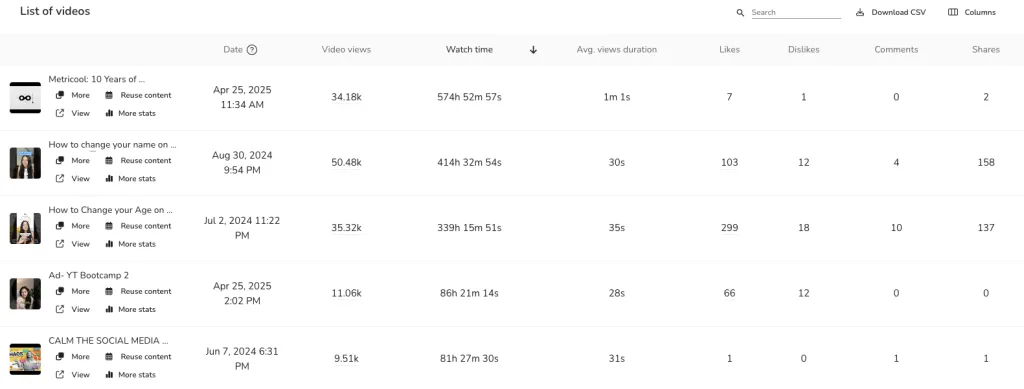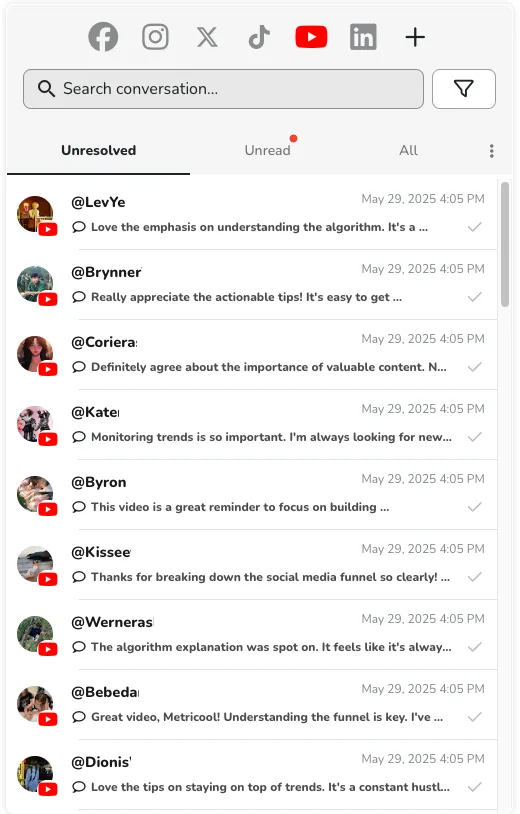How to Dominate the YouTube Algorithm in 2025

If you’re not actively working with the YouTube algorithm in 2025, you’re missing out on a colossal opportunity. Forget fighting against it; our mission at Metricool is to equip you with the knowledge and tools to turn this powerful system into your greatest ally. In our 2025 Social Media Study, we analyzed over 700,000 videos from more than 49,000 YouTube accounts and found that views increased by 8% in the past year. This number is sure to rise again this year, so if you want to tweak your strategy and take advantage of this trend, this article is for you.
Understanding the YouTube Algorithm: It’s All About the Viewer
YouTube isn’t just the world’s most popular streaming platform; it’s the second-largest search engine * and a colossal discovery tool. As with all social media platforms in 2025, we all usually sit back and let the YouTube algorithm tell us what to consume (🙋🏾♂️ guilty!). So, if you want your videos to reach their full potential, understanding how the YouTube algorithm works in 2025 is absolutely essential.
*Technically, YouTube is part of the world’s largest search engine, Google, as they own it and include YouTube videos in search results when relevant… but you knew that already.
How Does the YouTube Algorithm Work? The Short Answer
In 2025, the algorithm evaluates hundreds of signals, but here’s a simplified breakdown:
- Clicks – Are people intrigued enough to click your video?
- Watch time – How long do they stick around?
- Engagement – Do they like, comment, and share?
- Session Time – Do they keep watching YouTube after your video?
The algorithm’s job is to serve the right content to the right person at the right time.
A Deeper Dive
In 2025, YouTube’s recommendation system is more sophisticated and user-centric than ever. The core philosophy hasn’t changed: YouTube wants to keep viewers on the platform, watching content they love, for as long as possible. To achieve this, the algorithm prioritizes viewer satisfaction and personalization.
Think of it this way: the algorithm isn’t looking for “good” videos in a subjective sense. Instead, it’s constantly analyzing an immense amount of data to predict which videos an individual viewer is most likely to watch, enjoy, and continue watching. It’s a complex, AI-driven beast that learns from billions of signals every single day.
Here are the key factors the YouTube algorithm considers:
- Viewer Behavior Signals: This is the bedrock. What have you watched in the past? What channels do you subscribe to? What are you searching for? What videos do you like, dislike, comment on, and share? How long do you watch a video for? These personal preference signals are paramount.
- Video Performance: Once a video is shown to a viewer, how does it perform?
- Click-Through Rate (CTR): How often do viewers click on your video when it’s presented to them (in search results, home feed, suggested videos)? A high CTR indicates a compelling title and thumbnail.
- Watch Time/Audience Retention: How long do viewers actually watch your video? And, more importantly, what percentage of the video do they watch? High watch time and retention signal to YouTube that your content is engaging and valuable.
- Engagement Signals: Likes, dislikes (more on this later!), comments, and shares all tell YouTube that your video is sparking a reaction and interaction.
- Surveys: Yes, YouTube actively surveys viewers to gauge their satisfaction with recommended content. This direct feedback is incredibly valuable to the algorithm.
- Content Characteristics: What is your video about? YouTube uses its AI to understand the topic, genre, and even the tone and style of your content. This helps it match your video with interested viewers. This includes analyzing your title, description, tags, and even spoken words (through auto-generated captions).
- Context: Where is the viewer watching from? What device are they using? What time of day is it? These external factors can also influence recommendations.
In essence, the algorithm is constantly running experiments. It shows your video to a small group of viewers, measures their reaction, and if it performs well, it broadens the audience. It’s a feedback loop, and your goal as a creator is to consistently provide positive signals.
YouTube Algorithm 2025 Update: What’s New?
While the core principles remain, the YouTube algorithm 2025 update continues to refine its approach, emphasizing a few key areas:
- Hyper-Personalization and Satisfaction: This isn’t new, but it’s intensified. The algorithm’s ability to understand individual viewer preferences is constantly improving. It’s about finding the perfect content for that specific viewer, not just broadly popular videos. No two feeds are alike. This means creators need to obsess over their target audience.
- The Rise of Shorts and Long-Form Evolution: YouTube Shorts are a massive discovery tool in 2025. They run on a distinct algorithm that prioritizes quick engagement and “rewatchability” (how many times a user re-watches a short or loops it). Interestingly, Shorts can now be up to 3 minutes long, expanding storytelling possibilities within the short-form format. For long-form content, the focus is on deeper engagement, episodic content, and binge-worthy series. Both formats have their place, and strategically using Shorts to drive views to your long-form content is a smart move (more on that later).
- Community and Interaction: Audience interaction is more important than ever. YouTube is fostering stronger communities around channels. Live Q&As, community polls, active comment sections, and even the new “Hype” button (if implemented broadly) signal to YouTube that your channel is a vibrant hub of engagement.
- AI-Driven Content Analysis: Beyond keywords, YouTube’s AI is getting better at understanding the ins and outs of your content, including style, target audience, tone, emotions, and delivery. This means authentic and well-produced content that genuinely resonates with its intended audience will be favored.
- Global Reach (and Localization): With features like multi-language audio tracks becoming more common, the algorithm is increasingly designed to connect content with global audiences. This opens up huge opportunities but also emphasizes clear, universally understandable content. Slang and overly niche insider jokes might become less effective if you’re aiming for a truly global audience.
Dominating the Algorithm in 2025: 7 Actionable Tips
Now that we understand the beast, let’s talk about taming it. Dominating the YouTube algorithm isn’t about “hacking” it with tricks; it’s about consistently creating high-quality, engaging content that delights your target audience. Here’s your Metricool master plan:
1. Know Your Audience Inside and Out
This is the golden rule. Forget the algorithm for a second; focus on your viewer. Who are they? What are their interests, pain points, and desires? What kind of content do they crave?
- Dive into YouTube Analytics: This is your treasure map. Look at demographics, watch time, audience retention graphs (where do people drop off?), traffic sources, and what other videos your audience watches. This data will reveal what’s working and what’s not. You can find this data in YouTube’s native analytics or with Metricool, which allows you to dive even deeper, as well as compare with your other platforms.

- Engage with Your Community: Respond to comments, ask questions, run polls on your Community tab. The more you interact, the better you understand their needs and preferences.
- Create Viewer Personas: Develop a clear picture of your ideal viewer. What are their motivations for watching your content?
2. Master YouTube SEO (It’s Not Dead!)
While personalization is key, search remains a powerful discovery engine. YouTube SEO helps the algorithm understand what your video is about and who might be interested in it.
- Keyword Research is King: Use tools like Google Keyword Planner, TubeBuddy, VidIQ, or even YouTube’s search suggestions to find relevant keywords with decent search volume and manageable competition. Think about what your ideal viewer would type into the search bar.
- Compelling Titles: Your title is your first hook.
- Include your primary keyword naturally.
- Make it intriguing, benefit-driven, or curiosity-provoking.
- Keep it concise (ideally under 60 characters) to avoid truncation.
- Don’t be misleading (clickbait will hurt your retention!).
- Optimize Your Description: The first few lines are crucial as they appear “above the fold.”
- Include your primary keyword in the first 25 words.
- Write a comprehensive description (300-350 words is a good target) that tells YouTube and viewers what the video is about.
- Include relevant secondary keywords naturally.
- Add timestamps to help viewers navigate longer videos and boost SEO.
- Include relevant links (social media, website, related videos).
- Strategic Tagging: While not as impactful as they once were, tags still help.
- Use 5-8 relevant tags, including your primary keyword, variations, and related terms.
- Mix broad and specific tags.
- Transcripts and Closed Captions: These provide more text for YouTube to crawl, improving accessibility and SEO.
If you’re a content creator or social media manager, we know none of the above are your favourite parts of the job. Don’t be afraid to get some help with these tasks, with tools like Metricool’s AI Social Media Assistant available to assist with your titles and descriptions.

3. Craft Irresistible Thumbnails
Your thumbnail is your video’s billboard. It’s the visual trigger that makes someone click. It’s not a direct SEO factor, but it massively impacts your CTR.
- High Contrast and Readability: Use bold, legible text and contrasting colors that stand out.
- Show Emotion or Intrigue: A human face, especially one showing emotion, often performs well. Create a sense of curiosity.
- Consistency is Key: Develop a consistent visual style across all your thumbnails to build brand recognition.
- Don’t Mislead: The thumbnail should accurately represent your video’s content. A deceptive thumbnail will lead to low retention, which ultimately hurts your video’s performance.
4. Hook Your Viewers and Keep Them Watching (Watch Time & Retention)
This is where the magic happens. A high watch time and audience retention rate are the strongest signals to the YouTube algorithm that your content is valuable.
- Killer Intros (First 5-15 Seconds): You have mere seconds to grab attention.
- Clearly state what the video is about and what value the viewer will gain.
- Use a strong visual hook.
- Create a sense of urgency or intrigue.
- Pace Your Content: Keep things moving. Eliminate dead air, unnecessary rambling, and anything that doesn’t add value.
- Storytelling: Even in non-narrative content, a clear structure and flow keep viewers engaged.
- Vary Your Shots and Visuals: Don’t just show a talking head for 10 minutes. Use B-roll, graphics, text overlays, and different camera angles.
- Create Playlists and Series: Encourage binge-watching! Playlists tell YouTube that your videos are related and keep viewers on your channel longer.
- Use Cards and End Screens: Point viewers to other relevant videos on your channel or to subscribe.
Wash, rinse, repeat: Don’t let the haters say your first viral video is a fluke! Figure out why it was successful and repeat the steps. With Metricool you can see your views, watch time and engagement data side by side for multiple videos.

This makes it easy to compare video performance and replicate the best performing ones.
5. Use YouTube Shorts Strategically
Even if your main focus is long-form content, Shorts are a powerful discovery tool in 2025, especially for new channels.
- Quick Hooks: The first few seconds are critical as Shorts auto-play.
- Rewatchability: Can your Short be watched multiple times without losing its appeal? Looping elements work wonders.
- Trending Audio & Challenges: Hop on relevant trends to boost discoverability.
- Drive to Long-Form: Use your Shorts to tease your long-form videos or link to them in the comments or description.
- Experiment with Longer Shorts: With the 3-minute limit, you have more room for storytelling within the short-form format.
6. Engage, Engage, Engage!
The algorithm loves interaction because it indicates a vibrant community.
- Respond to Comments: Be active in your comment section, especially in the first few hours after publishing. This signals engagement. We know this can be annoying to manage across multiple platforms, which is why Metricool gives you access to a centralized inbox, allowing you to manage engagement for all your networks in one place.

- Ask Questions: Prompt viewers to comment and share their thoughts.
- Heart and Pin Top Comments: Highlight valuable contributions.
- Community Tab: Use polls, questions, and image posts to interact with your audience between video uploads.
- Go Live: Live streams are excellent for real-time engagement and fostering a stronger connection with your audience.
7. Consistency is Key (But Don’t Sacrifice Quality)
Does the YouTube algorithm favor consistency? Absolutely. Regular uploads train your audience to expect content from you, and it gives the algorithm more data to work with. However, consistency should never come at the expense of quality.
- Find Your Rhythm: Whether it’s once a week, twice a month, or daily Shorts, find a schedule you can realistically maintain without burning out.
- Maintain Content Quality: A consistent upload schedule of mediocre content will yield far worse results than less frequent, high-quality content. The algorithm prioritizes viewer satisfaction above all.
- Branding Consistency: Keep your video style, editing, and even your on-screen persona consistent. This builds brand recognition and viewer loyalty.
YouTube Algorithm for New Channels: Start Smart
Why It’s Harder for New Creators
No subscribers, no data, no past performance; this means new creators are often at a disadvantage.
How to Gain Traction with Zero Subscribers
- Create for search intent. Use titles people are Googling.
- Optimize every inch of your metadata.
- Post consistently so YouTube starts recognizing your niche.
Best Practices for New Channels
- Stick to one niche at first.
- Use eye-catching thumbnails.
- Engage with your comments—yes, it helps.
Tools to Track and Optimize Performance
YouTube Studio Analytics
Don’t just guess. Use Studio to track click-through, watch time, and retention curves.
Metricool for YouTube Strategy
Want a smarter dashboard? Metricool helps creators track performance, plan content, and even benchmark against competitors.
A/B Testing Thumbnails and Titles
Small changes can have massive results. Use tools to test and tweak until your CTR climbs.
The Human Touch: Creating for People First
- Building Community Over Virality: Viral videos are great, but loyal subscribers are gold. Focus on building relationships.
- Authenticity Is Your Superpower: Don’t fake it. The algorithm can’t measure “realness”, but your audience can.
- Viewer Signals vs. Vanity Metrics: Forget views for a second. Focus on watch time, retention, and shares. These are the real signals YouTube cares about.
FAQs: Debunking YouTube Algorithm Myths
Let’s address some common frustrations and misconceptions about the YouTube algorithm.
Why is the YouTube algorithm so bad?
This is a common sentiment, especially when views dip or a video underperforms. However, the algorithm isn’t “bad” in the sense that it’s intentionally trying to hurt creators. It’s an incredibly complex system designed to match viewers with content they’ll enjoy. When it seems “bad,” it’s often because:
- Your content isn’t resonating with your current audience: Perhaps your topic, title, thumbnail, or content delivery isn’t as compelling as you think.
- Your audience has changed: Viewer tastes evolve, and what worked last year might not work now.
- Increased competition: More creators are entering the space, making it harder to stand out.
- Misunderstanding of signals: Creators often focus on vanity metrics instead of core performance indicators like watch time and retention.
Instead of blaming the algorithm, shift your mindset to understanding what signals you’re sending it and how you can improve those signals to serve your audience better.
Did YouTube change its algorithm?
Yes, constantly! The YouTube algorithm is not a static entity. It’s an ever-evolving system that is continuously being tweaked and updated by YouTube’s engineering teams. These changes are often subtle, incremental refinements based on user behavior and broader platform goals (like promoting Shorts or podcasts). Major overhauls are less common, but the underlying principles are constantly being refined. So, yes, it changed yesterday, it’s changing today, and it will change tomorrow. Your job is to stay agile and adapt.
Do comments help the YouTube algorithm?
Absolutely! Comments are a strong positive signal to the YouTube algorithm. They indicate that your video is sparking engagement, discussion, and connection. The more comments you receive (especially meaningful ones, not just “first!”), the more YouTube sees your content as valuable and engaging. Replying to comments further amplifies this effect, showing YouTube that you’re fostering a community around your content.
Do dislikes affect the YouTube algorithm?
This is a nuanced one. In the past, dislikes were often seen as a purely negative signal. However, YouTube has stated that dislikes are not necessarily a direct negative ranking factor in the same way they once were. The algorithm now considers why a video receives dislikes. If a video is genuinely terrible or misleading, it will likely have low watch time and audience retention, which will hurt its performance.
However, if a video generates strong opinions (both positive and negative), but still maintains high watch time and engagement, the dislikes might not be a major deterrent. For example, a controversial opinion video might get dislikes, but if people are still watching it all the way through and debating in the comments, YouTube might still see it as engaging content for a specific audience. The key takeaway: focus on providing value and avoiding misleading content. If you’re getting dislikes because your content is genuinely poor, address the quality. If it’s a matter of opinion, don’t sweat it too much as long as other engagement metrics are strong.
Does the YouTube algorithm favor consistency?
Yes, as we covered, consistency is a significant factor. Regular uploads:
- Train your audience: Viewers learn when to expect new content from you, building anticipation and loyalty.
- Provide more data for the algorithm: More uploads mean more opportunities for YouTube to test your content with different audiences and learn what works.
- Signal activity: A consistently active channel suggests a committed creator, which YouTube appreciates.
However, remember the caveat: consistency with quality is what truly matters. Don’t sacrifice the quality of your videos just to hit an arbitrary upload schedule. Find a rhythm that works for you and your audience, and stick to it.
The Metricool Mindset: Data-Driven Dominance
At Metricool, we believe that dominating the YouTube algorithm in 2025 isn’t about guesswork; it’s about a data-driven approach combined with creative excellence. Our tools help you track the metrics that matter, understand your audience, and refine your strategy.
The YouTube algorithm is a powerful ally when you understand its objectives. By prioritizing viewer satisfaction, creating compelling and engaging content, optimizing for discoverability, and consistently analyzing your performance, you’ll be well on your way to conquering the YouTube landscape in no time.
Let’s Dominate the YouTube Algorithm Together
Content scheduling, advanced analytics, AI assistance & much more
Now you’re all set to create, analyze, and dominate! The stage is yours.


